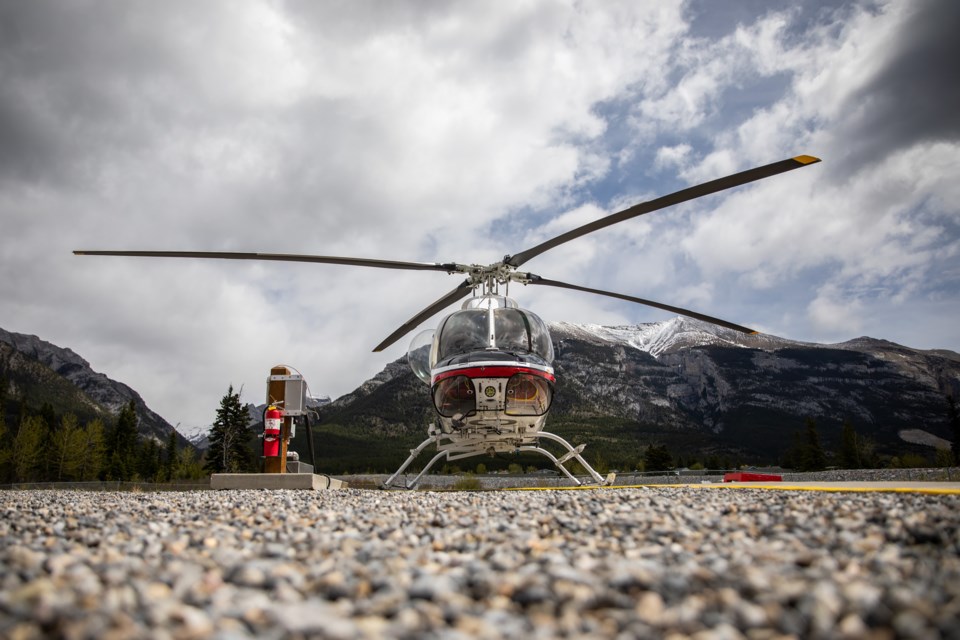CANMORE – A study on whether to potentially move forward with a search for a new heliport location will be decided upon during the 2022 capital budget deliberations.
Following lengthy and polarizing talks in the past year-and-a-half over the signing of a new 10-year contract with Alpine Helicopters, Town of Canmore staff brought forward a recommendation to examine new possible heliport locations.
The next council will ultimately decide whether or not to move forward with the study – estimated by Town staff to be about $75,000 – though if it were to go ahead, it does not guarantee a new site would be found.
“Obviously there's a number of concerns in the community, particularly noise in and around the heliport, but also greenhouse gases,” said Stephen Hanus, the Town’s manager of facilities.
“It's not easy to locate a heliport. There's always going to be some noises that are associated with the heliport, but this is a particularly unique type of noise in the community.”
If approved, the Town would hire consultants specializing in heliports to search for potential sites in and around Canmore. The criteria would include a site of proper size, access to utilities, proximity to residents and future developments, the Trans-Canada Highway and wind direction patterns.
The objectives would be to find a new location that has less impact on the community, but continues to be a feasible location for rescues and sightseeing tours.
“There'll be a lot of layers of information and lots of boxes will need to get ticked for a good site to be found,” Hanus said.
Hanus said a similar study was done to help pick the site of a new fire hall, and if the new council does put aside dollars for the project, it could find maintaining the status quo is the best option.
If it proceeds, the study would take nine to 12 months to complete and be finished in 2022.
The heliport was built in 1987 by the Alberta government and the Calgary Olympic Organizing Committee for the 1988 Olympic Winter Games. Once the Games were finished, the heliport was given to the Town.
A report from staff highlighted Canmore now has more than 14,000 residents, but the population was only 4,419 in 1988.
“At that time the town was fairly small and had about 4,500 people with minimal tourism until the Olympics,” Hanus said. “It wasn’t very developed in and around the heliport and at the time it was chosen as the correct spot. It’s been a while since we’ve taken a look at that.”
A heliport commission was created in 1988 with both public and council members. Since then, three different companies have operated out of the site for both sightseeing tours and commercial and emergency services.
The Airport Vicinity Protection Area (AVPA) was approved between the Town and the province in 1991 and made part of Canmore’s land use bylaw. The AVPA was created for helicopter departure and approach paths as well as restrictions on building heights and sound insulation requirements.
Canmore council approved a 10-year agreement between the Town and Alpine in July. The contract has yet to be signed, pending legal review and final approval of both sides.
The new deal would see sightseeing tours reduced to no more than 35 flights a day and the minimum duration set at 25 minutes. Tours would also only be allowed between 8:30 a.m. and 5 p.m.
The change in flight duration and numbers is also designed to reduce greenhouse gas emissions and create less noise in the primarily residential area.
Under the previous agreement, Alpine was permitted to fly up to 60 times a day for sightseeing purposes.
Under the existing contract, Alpine pays $109,939 a year or roughly $9,161 a month.
At the July meeting, staff deemed fair market at $135,000 a year or $11,250 a month. However, since Alpine's business operations would be limited by the decision, the rent was reduced to $115,000 or $9,583 a month for about 15 per cent below fair market rent level.
The new contract, when approved by both sides, would be raised annually based on the consumer price index. The contract would also allow either side to give 24 months notice to terminate the lease agreement and renegotiate if a new site is found.
Alpine would also pay a total of $10,100 in property taxes in 2021.
The Town and Alpine have had a lengthy negotiation in agreeing to the new contract. Beginning more than a year ago, the Town also held a virtual town hall in May where 31 people spoke in either opposition or support.
A survey was also sent to 22 organizations – generating 12 replies in a 58-day span – and four groups having additional discussions with the Town further informed staff and council.
At the annual Heliport Monitoring Committee in April, Alpine said it was committed to having new technology installed on helicopters to reduce some noise, but all new technology and equipment have to be first approved by Transport Canada and the helicopter’s manufacturer.
The committee also discussed further noise reduction options, such as a transparent barrier around the heliport and planting trees around the perimeter. Both concepts had flaws and didn’t move forward.
In 2019, Alpine did 201 rescues and 161 in 2020, according to statistics presented at the Heliport Monitoring Committee.
In committee meetings in the coming years, the annual report will include data such as fuel use and flight data, but that will be kept confidential from the public due to it being proprietary to Alpine.
The budget deliberations will take place shortly after the Oct. 18 municipal election and be the first major task of the new council.
“This is going to be an interesting process. It has to compete against all the other capital projects, and we have a very constrained fiscal budget,” Hanus said. “So I will see if it gets approved. It’s not a slam dunk. It definitely has to compete against everything else.”




